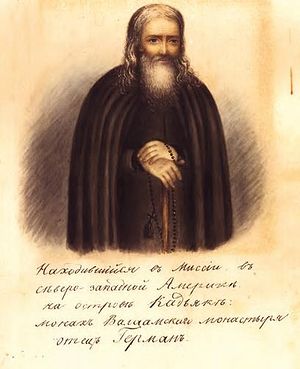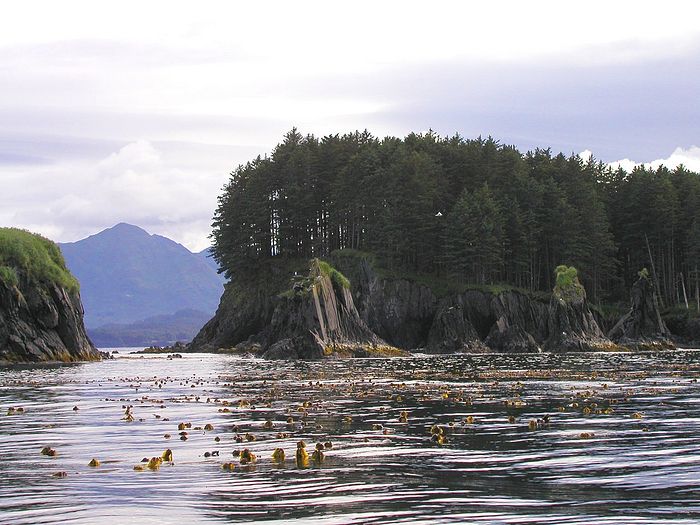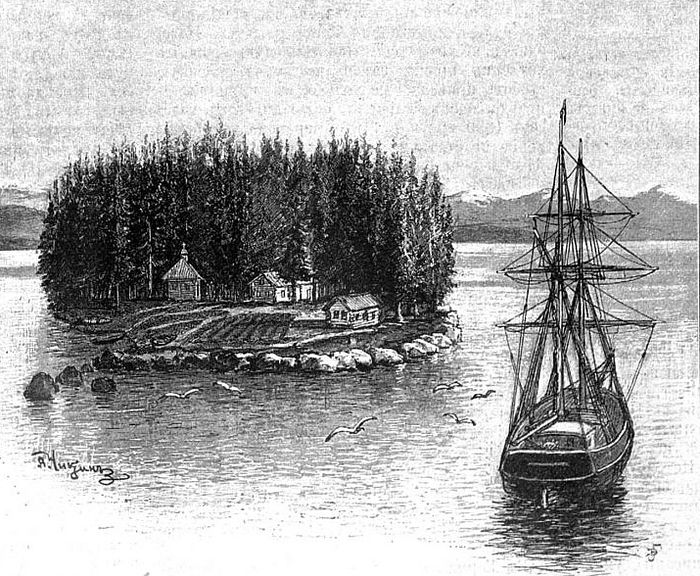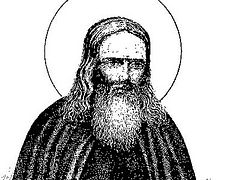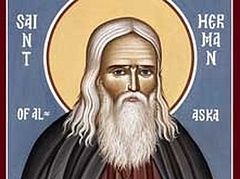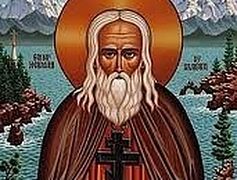St. Herman of Alaska was a marvelous God-pleaser. His life of humility and ascetic labors will ever endear him to us as a speeder helper and intercessor, whose prayers have boldness before the Lord. Truly his life was filled with miracles, and miracles continue to happen through his intercessions—he is especially quick to help his Alaskan people, and orphans everywhere. For his commemoration day we have gathered a few of St. Herman’s miracles.
Miraculous Healing on Valaam
At the Saint Sergius Hermitage [on Valaam] there occurred the following incident to Father Herman. On the right side of his throat under his chin there appeared an abscess. The swelling grew rapidly, disfiguring his face. It became difficult for him to swallow, and the odor was unbearable. In this critical condition Father Herman awaited death. He did not appeal to a physician of this world, but locking his cell he fell before an icon of the Mother of God. With fervent tears he prayed, asking of Her that he might be healed. He prayed the whole night. Then he took a wet towel and with it wiped the face of the Most Holy Mother, and with this towel he covered the swelling. He continued to pray with tears until he fell asleep from sheer exhaustion on the floor. In a dream he saw the Virgin Mary healing him.
When Herman awoke in the morning, he found to his great surprise that he was fully healed. The swelling had disappeared, even though the abscess had not broken through, leaving behind but a small mark as though a reminder of the miracle. Physicians to whom this healing was described did not believe it, arguing that it was necessary for the abscess to have either broken through of its own accord or to have been cut open. But the words of the physicians were the words of human experience, for where the grace of God operates there the order of nature is overcome. Such occurrences humble human reason under the strong hand of God’s Mercy.
St. Herman’s prayers stop a flood
On Spruce Island there once occurred a flood. The inhabitants came to the Elder in great fear. Father Herman then took an icon of the Mother of God from the home where his students lived, and placed it on a “laida” (a sandy bank) and began to pray. After his prayer he turned to those present and said, “Have no fear, the water will not go any higher than the place where this holy icon stands.” The words of the Elder were fulfilled. After this he promised the same aid from this holy icon in the future, through the intercessions of the Mother of God. He entrusted the icon to his disciple Sophia; in case of future floods the icon was to be placed on the “laida.” This icon is preserved on the island to this day.
Stopping the forest fire
Once, the forest on Spruce Island caught fire. The Elder, with his disciple Ignaty, in a thicket of the forest made a belt about a yard wide in which they turned over the moss. They extended it to the foot of the hill. The Elder said, “Rest assured, the fire will not pass this line.” On the next day, according to the testimony of Ignaty, there was no hope of salvation (from the fire) and the fire, pushed by a strong wind, reached the place where the moss had been turned over by the Elder. The fire ran over the moss and halted, leaving untouched the thick forest which was beyond the line.
Changing the winds
In 1842, five years after the passing away of the Elder, Archbishop Innocent of Kamchatka and the Aleutians, was near Kodiak on a sailing vessel which was in great distress. He looked to Spruce Island, and said to himself, “If you have found favor in God’s presence, Father Herman, then may the wind change.” It seems as though not more than fifteen minutes had passed, said the bishop, when the wind became favorable, and he successfully reached the shore. In thanksgiving for being saved, Archbishop Innocent himself conducted a Memorial Service (Panikhida) over the grave of the blessed Father Herman.
Reproach at the Spring
 Saints Sergius and Herman of Valaam Chapel, built in 1898 over the site where Herman was buried on Spruce Island in December 1836. Photo: wikipedia.org
Saints Sergius and Herman of Valaam Chapel, built in 1898 over the site where Herman was buried on Spruce Island in December 1836. Photo: wikipedia.org This time V. K. was not alone, but with other residents of Kodiak. On the way to the spring V. K. remembered his wife’s request to bring St. Herman’s water. But he had no bottle, except for a bottle with wine, which was being saved for the return trip. Without thinking long about it V. K. drank the contents, proposing to rinse the bottle and fill it with Father Herman’s water...
Coming to the spring, however, V. K. saw that the water was as if boiling, raising to the surface various kinds of filth, and for as long as V. K. waited the water continued to be turbulent, becoming muddy and unsuitable for drinking. And so he left for Kodiak, without drinking the water or bringing any home.
“For a long time,” V. K. told me, “I told no one of this, but I didn’t stop thinking of what had happened until I went again to Spruce Island.” This time he took with him no “provisions.” After landing on Spruce Island, he went immediately to the spring. The water was transparent, as pure as tears! “I drank the water for a long time and came to believe that the Elder, showing me such a sign, was really a man of holy life,” he told me. Having returned home, he related what had happened to him. And from that time no one again would dare to go to Spruce Island without proper reverence, but would go there to venerate the Saint and be refreshed by his holy water.
This incident, so similar to the incident of St. Seraphim of Sarov and the Decembrist at the spring—whose suddenly muddy waters, the Saint related, were a sign of the evil nature of this revolutionary’s schemes—has never appeared in print before. Wondrous is God in His saints!
From Little Russian Philokalia, Vol. III: St. Herman
(St. Herman Press)
Archpriest Alexander Popov
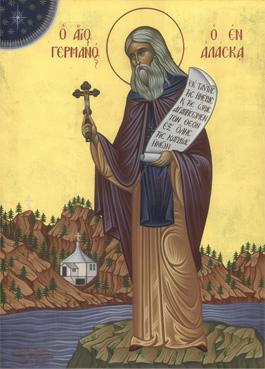
Both Leo and Kathleen were serious enthusiasts of mountaineering and rock climbing, and so for their honeymoon trip they decided to go to Alaska to bag the highest peak of North America, mount Denali (aka McKinley), 20,320 feet. While living at the camp at the foot of the mountain, they thoroughly prepared their expedition: talking to guides, studying the maps, checking the equipment, and waiting for a long stretch of good weather.
When they finally started their exciting, but extremely difficult, ascent, everything went just fine for a few days. But at the end of one day, on a narrow path, they met an old, strange-looking man in a long dark robe. He was walking in the opposite direction, down the mountain. In a friendly manner he greeted them and advised them to turn around and return to the base camp as quickly as possible because the weather was changing into a severe storm. Soon, he said, it will be very dangerous around here. And, as if in answer to their unasked question of how could he know such a thing, he explained that he was local and knew the climate very well. Leaving them surprised and uneasy, he continued on his way.
Some minutes later, after Leo and Kathleen made the wise decision to turn back, and then tried to recall the appearance of the old man, they realized that they hadn’t seen a backpack or any other hiking gear with him. How could he have made it up so high in the bare, rocky mountain in sub-zero temperatures, without any food or protection?!
A few days later, almost at the bottom of the mountain, they were indeed caught by a severe storm. They survived it, constantly in their minds thanking the old man who had warned them of the danger. A week later, still staying at the base camp, they learned that some other climbers, who happened to be at higher elevations than they were during the storm, never came back.
Then, as if in answer to their curiosity, Leo and Kathleen noticed something at the camp cafeteria. It was a picture of their rescuer, pinned on a bulletin board between some miscellaneous ads and photos of the mountain. They recognized him at a glance. When they asked the waiter for his name, he told them, “It's an Orthodox saint who lived in Alaska. His name is St. Herman.” And the photo showed the icon of St. Herman from the Orthodox Church nearby.
The Saint had told them the truth. He was indeed a local guy...
Matushka Galina Tregubov and Lee Browne-Beed

